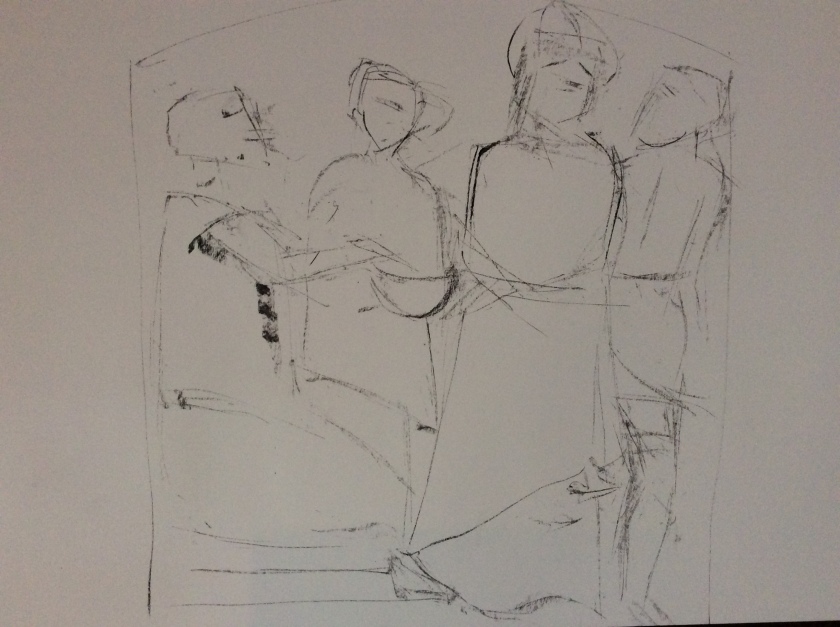Sensations
The Chapel is completely silent, heavily silent, in a way that is rare in a town. My skin feels that slight itchiness after only a minute. The salty air? Or the deadness that permeates a building with no opening windows?
A mower starts up nearby and masks the life that exists outside the Chapel, someone hammering, birdsong, the distant sound of traffic. Someone enters, crosses herself and observes. After a minute she is gone. I busy myself, the sensations melt.
Back alone the mowing has stopped. The air has an iciness. Prepared, I am wearing three layers when a T-shirt would suffice outside. I am willing the building to converse, but all that seems to have happened is my face, arms and legs are getting colder and my back is aching. Pews designed for suffering!
I have come specifically to work at the north west altar.  No special reason why this altar other than the words are easily accessible. I want to combine the traced words with an ink painted image on top. I choose the angels. Why not! This is when I realise the problems of working on site.
No special reason why this altar other than the words are easily accessible. I want to combine the traced words with an ink painted image on top. I choose the angels. Why not! This is when I realise the problems of working on site.
I trace more words with charcoal and hands, and charcoal an image of an angel.  Interestingly the words traced by hand with charcoal dust (at the bottom), look more manufactured than those without direct human contact.
Interestingly the words traced by hand with charcoal dust (at the bottom), look more manufactured than those without direct human contact.

My hands look like a miner’s. Everything I touch I leave my mark. There is nowhere to wash them. I plough on. I struggle to open a large bottle of ink. I am new to ink but it seemed a suitable medium to dry quickly and be transportable. It appears I can only pour into a smaller container, which I haven’t brought. There is no direct access for a brush. Ho hum!
I glue the words onto paper. Nowhere to clean the brush, no bag to transport.
I draw over the glued tissue, which moves, disobligingly under the charcoal, which I hadn’t intended to use. Lesson learnt. Next time..
 I return to the pew to give my knees a rest. Looking at the main altar I am reminded that once you see something it is difficult to unsee. I see two ghosts with their arms raised, to the left, above the figures, and two girls to the right with long bunches, similar to the characters in a manga comic. I sit there wondering why the Catholics would make such a homage…. clearly time to stop.
I return to the pew to give my knees a rest. Looking at the main altar I am reminded that once you see something it is difficult to unsee. I see two ghosts with their arms raised, to the left, above the figures, and two girls to the right with long bunches, similar to the characters in a manga comic. I sit there wondering why the Catholics would make such a homage…. clearly time to stop.


 I work with tissue for its textural and unpredictable qualities, so this could be a natural extension to that practice.
I work with tissue for its textural and unpredictable qualities, so this could be a natural extension to that practice.









 Normally the left hand produces a less controlled image, but not this time.
Normally the left hand produces a less controlled image, but not this time.






